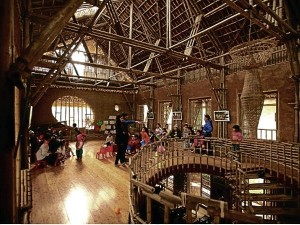
SUOI RE VILLAGE COMMUNITY HOUSE, VIETNAM, built from indigenous materials, such as bamboo and rammed earth, is designed as a multi-functional meeting place for the village members. It has solar panels, rainwater harvesting system, geothermal heating and LED lighting. Photo from inhabitat.com
IMAGINE IF developing countries occupying almost two-thirds of the world’s total population will follow the lead of the developed countries in terms of consumption and carbon emissions.
The growth of these developing countries would then be characterized by heavy environmental impact coupled with globalization that destroys cultural differentiation.
The new sustainable city teaches its citizens to harmonize what is global and what is local. Environmental and cultural responsibility guide the development of the new sustainable city.
Singapore’s example
One important area in a sustainable city’s development is housing. Sensitivity to the needs of the homeless is a true mark of development. Singapore’s significant growth started when they took a determined effort to provide public housing in the 1960s. Today some 80 percent of Singaporeans are enjoying world-class public housing—all because of the foresight and hard work of their leaders.
One-third of the world’s urban population lives in inadequate shelter. Most of those affected here fall under the poverty line.
Real estate development does not reach the base of the population social pyramid. The poor construct their own makeshift homes. The cost of traditional construction materials is beyond their means.
To help people live in a more sustainable way calls for positive programs like education and good governance.
Part of this education could be to develop materials and systems from available resources within each locality.
Rethinking our values and local resources will give us more rootedness and will help us to be more creative and innovative. We need to build confidence in our identity for our cultural survival as we interact in the global village.
The miracle plant
One way to accomplish this is by utilizing a local resource, a rapidly renewal material—the bamboo, nicknamed “the miracle plant.”
Bamboo is not a tree. It belongs to a subfamily of the perennial grasses. Its stems can be harvested several times from the same plant.
Bamboo is an extremely fast-growing plant. While it takes 10 to 20 years for most woods to be harvested, bamboo takes only three to five years to become a load-bearing member in structures.
Bamboo has many practical applications. It is now widely used for flooring and paneling. Its pulp is used for paper-making and it acts as a raw material for construction and reinforcement.
In some parts of Pakistan for example, they use natural building materials like earth and bamboo. These materials not only are low-cost and more energy-saving than brick and concrete, but are also less susceptible to the weather effects.
Design competition
The Hilti Foundation together with the United Nations Economic and Social Commission for Asia and Pacific, and the Homeless Peoples Federation of the Philippines, is sponsoring a design competition for affordable and modern bamboo housing for low-income groups in the Philippines.
The materials considered are round bamboo and bamboo-based panels. Technical research and development on the characteristic values of round bamboo, panel and adhesive technologies, jointing techniques and construction systems is aimed to lift bamboo construction to a new level of profession.
The design should address the economic, social and environmental challenges of urbanization in Asia. The project aims to promote the production and application of affordable, alternative building materials and disaster-resilient housing concepts in urban contexts of Asia and the Pacific.
Deadline of submission of proposals, designs and models is on Aug. 31, 2012.
Interested parties may direct their inquiries to Corinna.Salzer@hilti.com.
For comments or inquiries, e-mail amadodejesus@gmail.com.

